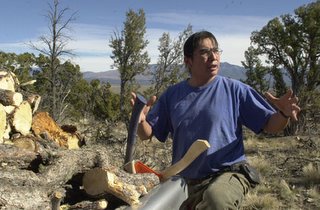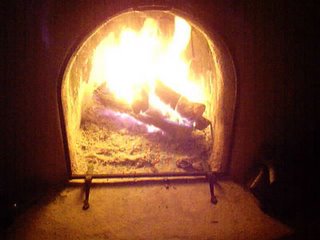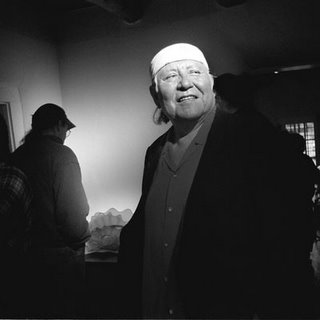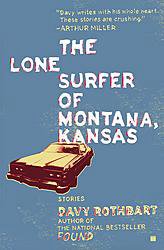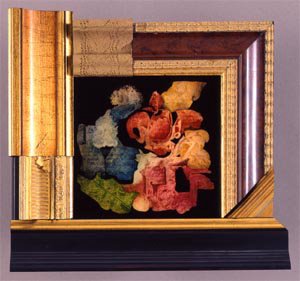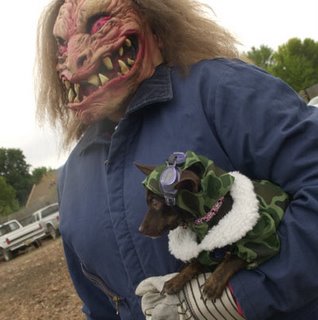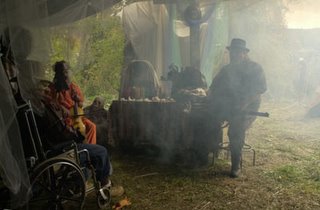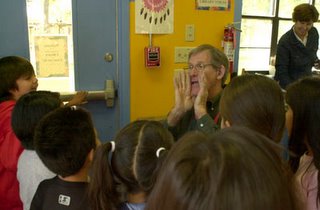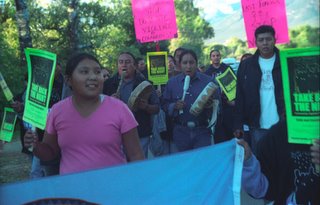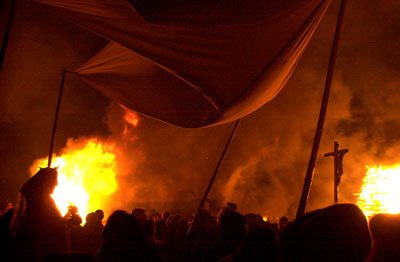
Photo by Rick Romancito.
It is just before sunset and the bell at San Geronimo Church at Taos Pueblo calls everyone to Vespers. Already, parking is difficult and grid lock grips the road that leads directly into the Native American village from the Northern New Mexico town.
Hundreds of people stand and wait or troop through the crunchy snow and follow what is left of the sunlight as it warms the clarified air with the last of its horizontal rays. Frigid temperatures, high altitude and fresh snow on Taos Mountain make everything brighter and clearer while the shadows lengthen and deepen. Stacks of fragrant pitch wood arranged in a lattice pattern, called luminarias in Spanish, stand ready to be set ablaze just as the sun goes down.
The Village on Christmas Eve
The plaza of the Taos Pueblo village is divided by the Rio Pueblo. The adobe apartment-style buildings have been continuously inhabited since about 1000 C.E. They are arranged on the north and south sides of the river. People who live on the Taos Pueblo Indian Reservation still maintain homes in the village and some even use their family’s ancestral dwellings as their main house today. Within the village walls there is no electricity or running water.
People from town who come to the village for the Christmas Eve Procession come for various reasons. Some non-Indians have ties through marriage or other close relationships. Whole sides of old Spanish families are represented by their delegates (primas y primos, in-laws and exes) on the plaza at Christmas Eve. Others – often the more alternative factions of town-dwelling Anglos (geezer and neo hippies, artists, poets and movie stars) cluster in their buffalo coats, purposefully goofy Andean headgear and lined Sorrell boots. There are even tourists.
Everyone is waiting for the procession to begin. The sun is down. People are always asking “what time is it going to happen?” and the Indian answer is always “when they’re ready.” No matter what time your watch says, when it finally happens, it is the right time. Men with lighters start up a couple of the smaller bonfires. People crowd around trying to get warm. Anticipation builds.
Los MatachinesThis year, the tribe will be dancing the Matachines dance. Called a beautiful dance of subjugation by anthropologist Sylvia Rodriguez, the dance is said to have its roots in medieval folk dramas symbolizing conflict between the Christians and the Moors. Rodriguez writes that while the dance may have been brought to the Americas as a way to Christianize the native people, it has become a contemporary method of “coping with and commenting on the history of ethic domination as it continues to unfold in the upper Rio Grande valley.”
Taos tribal members do not consider Los Matachines to hold the same sacredness afforded the Deer or Buffalo Dance and other performances associated with their native religion, however the Matachines remains a vital aspect of their traditions.
To be selected to dance is an honor and much care and expense is taken to make sure each part of the costumes are just so. The cupillas (mitre-like headdresses), ribbons, palmas and jewelry must all be within traditional guidelines. The young girl who portrays La Malinche is usually dressed like a little bride.
The Abuelos and El Toro, seem to represent the rough, animal side of nature. They are frightening as they stand on the rooftops of the buildings and shout rude things onto the people below. They jibe and their antics provoke laughter, but one is careful to move out of the way when they shout to move along in Spanish or Tiwa and crack their whips.
At one bonfire, a handful of Texas college boys are getting warm. Suddenly, the one on the end realizes Abuela is standing next to him. He gapes at the ugly paper mache mask and misshappen head, the stuffed chest in the sweater with dollar bills pinned to it and the loud, flowered skirt. He nudges his friend. In appreciation of the boy’s curiousity, Abuela raises her dress over her head.
This year, there is a nearly full moon for Christmas Eve in a clear, darkening sky. The smoke from the bonfires is thick. Sometimes the columns of black smoke lay down on the ground – swamping us in their sooty storm. Sparks fly in the frigid wind that flows off the snow-capped mountains as night falls. The church bell sounds, marking the end of Vespers.
The ProcessionSan Geronimo church is fronted by an adobe wall courtyard enclosure. The doorway is arched and now, as everyone is assembled just outside the archway, torches are lit. Huge bundles of kindling are bound together. They are heavy and must be carried in both arms and when the wind blows, sparks fly in all directions.
Several men with rifles fire into the air. People flinch and cry out if they are not expecting it. Even if you know it’s going to happen, when the first gunfire sounds, it still makes you jump and start.
Men playing hand drums and singing in Tiwa follow, and the sea of people parts for them, but not quite enough. Los Abuelos yell and scold everyone to get back. Whips crack and curses are hurled.
In the courtyard of the church, the statue of Mary, which is usually displayed at the front of the church instead of the usual crucified Christ, is now dressed as the Bride of Heaven. She is carried on a platform decked with green pine bows. A canopy of white material is carried over the santo – perhaps as a reference to the Jewish marriage ceremony, but maybe the canopy is just there to protect the painted face and white vestments of the santo from falling ash and sparks from the torches and bonfires.
Some years the Archbishop of New Mexico and other important priests from the Diocese take part in the procession, carrying the crucifix. This year it is just the local luminaries of San Francisco de Asis in Ranchos de Taos or the church downtown, Our Lady of Guadalupe.
The Matachines dancers follow, with their musicians, a rhythm guitarist and a violinist. They scratch out a strange and repetitive tune that the dancers must move to over and over, both in the procession on Christmas Eve, but also Christmas Day.
Next is a group of women from the choir singing carols in Spanish and Tiwa. Behind them, everyone files in behind.
The fire burns into the nightOnce the statue of Mary has been taken around the plaza, and the dancers have performed the dance in the necessary places, Mary is returned to her place at the altar while the crucifix takes its usual place to the right hand side of the nave.
The bonfires burn down to embers. We go home and have hot chocolate before heading to the family home to open presents with our relatives. As we cross the bridge my husband turns to take one more picture of a group of maybe 200 people standing around what had been the biggest bonfire on the plaza – as tall as three men.
Now the embers still glow hot enough to warm all these people and send them home with the warmth of a shared tradition and the promise of a return of the sun, when we take this light we have found, and escort it into the New Year.
 The old saying goes, "Red sky at morning -- sailors take warning." Though sailors are few and far between here in this inland sea, what is certainly meant is that the afternoon will be especially windy. This has certainly been the case as we slide into the holiday season.
The old saying goes, "Red sky at morning -- sailors take warning." Though sailors are few and far between here in this inland sea, what is certainly meant is that the afternoon will be especially windy. This has certainly been the case as we slide into the holiday season.


